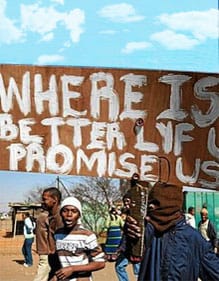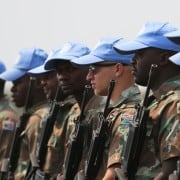|
Getting your Trinity Audio player ready...
|
 If you ever wanted confirmation that the level of corruption in a country and that country’s potential for peace – or unrest – are linked, a new study provides just that. Research from the Institute for Economics and Peace (IEP) shows that corruption is so corrosive that it’s a leading indicator for political instability and unrest.
If you ever wanted confirmation that the level of corruption in a country and that country’s potential for peace – or unrest – are linked, a new study provides just that. Research from the Institute for Economics and Peace (IEP) shows that corruption is so corrosive that it’s a leading indicator for political instability and unrest.
The study found that there are 64 countries, all struggling with widespread fraud and bribery, which risk falling into violent upheaval in the not very distant future – unless there is a speedy turnaround. Most of the countries below the tipping point are developing nations, and none of them are full democracies.
In examining the link between corruption measures and peaceful societies, the IEP’s research found strong statistical evidence that high and rising levels of corruption can undermine security, and that only small increases can cause civil unrest.
The main findings indicate that
* Corruption is the only explanatory variable used in every model which shows consistent and significant correlations with a variety of key peace and violence indicators.
* While corruption has an impact on peace, peace is not statistically significant in influencing corruption; this highlights the one-way nature of the relationship.
The most striking aspect of the corruption-peace relationship is the presence of a ‘tipping point’, according to the IEP. If a country has low levels of corruption then increases in corruption will have little effect on peace but once a certain threshold is reached, small increases in corruption can result in large decreases in peace.
The IEP examined trends in peace and corruption over the past 15 years by looking at Transparency International’s Corruption Perception Index (CPI), the World Bank’s Control of Corruption measure, and its own Global Peace Index.
It found that when a country’s CPI score is under 40 out of a possible 100 that would denote minimal corruption, it has reached a threshold for collapse of government institutions and a rise in internal violence, IEP said.
Download the report for more insights, information on methodology, explanation of statistical methods used, and trends in peace and corruption over the last 15 years.
Corruption in police, government and judiciary can tip the scales
The analysis also shows that corruption within the police, judiciary and government are the most statistically significant forms of corruption associated with decreasing levels of peace. The relationship between the tipping point and peace can be explained by high levels of corruption in these institutions.
Countries with the strongest democratic institutions tend to be both the most peaceful and least corrupt, IEP found. And perceived corruption in the police and judiciary is much lower in countries above the tipping point compared to those countries near or below it.
The IEP has identified 64 countries that could be seen as approaching the tipping point. South Africa is not one of them, although in the Southern African region, Swaziland, Angola, Mozambique, Zambia and Malawi were named. Other countries among the 64 include Greece, Argentina and China.
South Africa’s judiciary is still relatively independent, despite unrelenting political pressure, and it has handed down some morally satisfying judgments of late. One of the most significant was the Pretoria High Court’s 15 June ruling that Sudanese president Omar al-Bashir must be detained in connection with a formal request for his arrest from the International Criminal Court – a move that was certainly not in line with the South African government’s thinking.
Almost immediately after the order was made, the court was informed of the strong possibility that Al-Bashir was no longer in the country, and this turned out to be the case. Speculation that the government helped the war criminal to cross the border has been rife ever since.
The South African police, however, is another matter. Hardly a week goes by without media reports of officers being fingered for corrupt activities. In April, none other than the Western Cape Police Commissioner Arno Lamoer, with four other accused, was charged with 109 counts of corruption, fraud, money laundering and defeating the ends of justice. They were by no means the first, nor will they be the last.
Increases in police and judicial corruption directly undermine the rule of law – this increases political instability and can lead to the collapse of those institutions which were designed to prevent violence and conflict. In some cases the police force is no longer useful in controlling crime and corruption, but is actually a part of the problem.
This situation of corrupt police and judicial systems is a threat to long term peace within a society. These two institutions are therefore critical in keeping the level of violence within society to a minimum, and improving peace.







